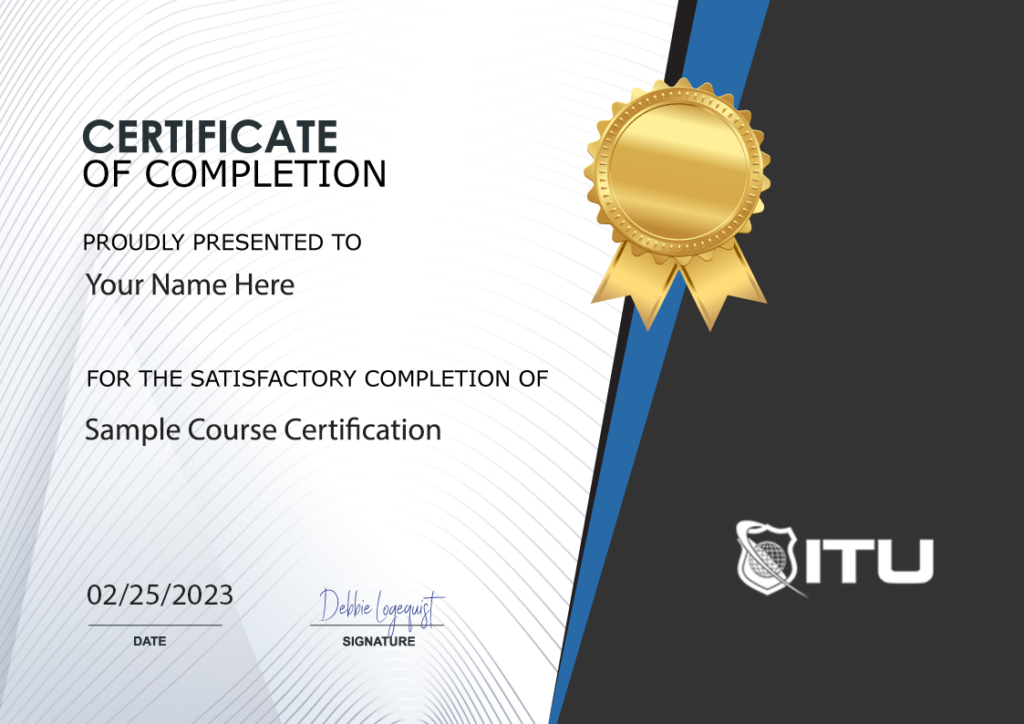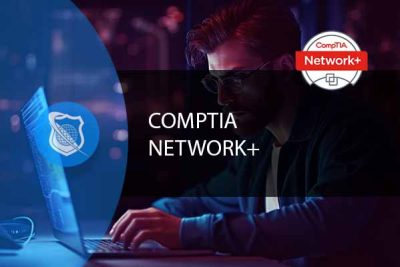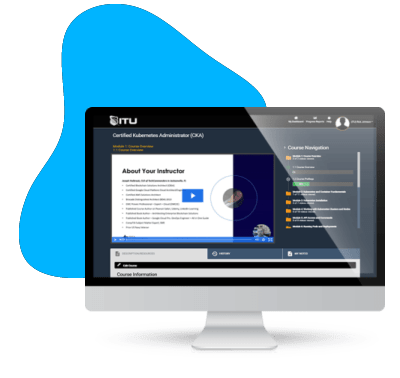
Lifetime
An ITU Online Training exclusive. The only Buy Once, Never Pay for IT training again program available. Plus, get all new and updated content for life.

With an All-Access Pass, you get access to every current and future ITU course. Access over 2,500 hours of on-demand IT Training 24/7. With over 13,000 on-demand training videos and 19,000+ practice questions, you'll have the tools to excel in the critical IT skills needed to elevate your IT Career. Our All-Access pass is available in three affordable plans.
Paris is the capital of France.
Tokyo is the capital of Japan.
Most Popular
Categories

With an All-Access Pass, you get access to every current and future ITU course. Access over 2,500 hours of on-demand IT Training 24/7. With over 13,000 on-demand training videos and 19,000+ practice questions, you'll have the tools to excel in the critical IT skills needed to elevate your IT Career. Our All-Access pass is available in three affordable plans.

ITU provides a vast array of IT-focused on-demand training designed to help you excel in both entry-level and advanced IT skills. Browse our most popular training or take a deper dive into our robust catalog of training categories.
Popular Courses All Categories




This Comptia Network course equips students with the essential skills, hands-on experience, and knowledge needed to design, build, and manage functional systems. It also covers maintenance and troubleshooting across various aspects of modern digital infrastructure. Upon completion, students will have a comprehensive understanding of all the objectives required to pass the CompTIA N10-008 exam, along with adequate preparation for the certification process.
Included In This Course
Closed Captions
Certificate of Completion
Course Description
The CompTIA Network+ N10-008 course offered by ITU Online IT Training is a comprehensive certification program designed to provide individuals with the essential skills and knowledge required for a career in networking. The course covers a wide range of topics, from fundamental networking concepts to advanced technologies like virtualization and cloud services. It aims to prepare students for the CompTIA N10-008 exam, which is a globally recognized certification validating one’s ability to design, configure, manage, and troubleshoot wired and wireless networks.
The course includes 46 training hours, 189 on-demand videos, closed captions, 16 topics, and 179 prep questions. Upon completion, students receive a certificate of completion and are expected to have a deep understanding of all the objectives required to pass the CompTIA Network+ N10-008 exam.
This certification that validates your ability to design, configure, manage, and troubleshoot wired and wireless networks is globally recognized. The N10-008 exam is designed to test your proficiency in various areas of networking, ensuring that you possess the necessary skills to excel in the industry.
A handy CompTIA Network+ N10-008 Objectives PDF guide to use while training to ensure you cover each domain’s objectives to aid in successfully passing the CompTIA Network+ N10-008 Exam.
To lay a strong foundation, the Network+ N10-008 exam starts with assessing your grasp of fundamental networking concepts. This includes understanding the OSI and TCP/IP models, network topologies, protocols, and addressing schemes. Demonstrating expertise in these concepts proves your ability to comprehend the intricacies of modern networks.
The Infrastructure domain focuses on the physical components of networks. It covers topics like switches, routers, firewalls, and cables. Candidates are expected to be well-versed in network device installation, configuration, and management. Mastering this objective equips you with the skills needed to build robust and scalable networks.
Efficient network operations are crucial for ensuring smooth functionality. The N10-008 exam assesses your understanding of network security concepts, best practices for network management, and troubleshooting techniques. This objective aims to test your ability to keep networks secure, reliable, and optimized.
In an increasingly interconnected world, network security is of paramount importance. The Network+ N10-008 exam evaluates your knowledge of various security measures, including firewalls, VPNs, access control, and threat mitigation. Acquiring expertise in this domain is essential for safeguarding networks against potential cyber threats.
The ability to identify and resolve network issues efficiently is a valuable skill for any networking professional. This objective tests your proficiency in troubleshooting methodologies and the usage of network diagnostic tools. Mastery in this area ensures that you can quickly resolve problems and minimize network downtime.
The Network Technologies domain dives into advanced networking concepts like virtualization, cloud services, and unified communications. Understanding these technologies is vital as they are becoming increasingly prevalent in modern network infrastructures.
By mastering the objective for exam N10-008 and obtaining the CompTIA Network+ N10-008 certification, you demonstrate your networking prowess and open doors to exciting career opportunities. Through comprehensive coverage of essential networking objectives, this certification equips you with the knowledge and skills necessary to excel in the field.
By dedicating time and effort to understanding and applying the CompTIA Network+ N10-008 objectives, you can confidently face the exam and build a solid foundation for a rewarding career in networking. So, seize this opportunity, embrace the challenge, and embark on the path to becoming a certified networking professional!
At the conclusion of this course there is a comprehensive practice test that will gauge how well the student has mastered the practice exams and many topics network problems and N10-008 objectives presented throughout the course. This practice test can be taken multiple choice or as often as needed to ensure that the student is prepared to enter this field with the confidence physical security of knowing that they have gleaned the maximum benefit from this course.
CompTIA Network+ N10-008 Objectives Unlocked – The landscape of the IT industry has been undergoing dramatic changes. In response to these changes, IT certifications have become an essential part of career advancement. Among these certifications, CompTIA Network+ N10-008 stands out due to its comprehensive coverage of networking concepts.
Earning a CompTIA certification opens up a world of exciting career opportunities in the field of networking. As businesses increasingly rely on robust and secure network infrastructures, the demand for skilled professionals continues to grow. In this blog, we will delve into the various positions that a CompTIA Network+ certified individual can pursue and explore the associated high and low salaries. Additionally, we will highlight some typical responsibilities that come with each job title.
| Job Title | Potential Responsibilities | Low Salary Range | High Salary Range |
|---|---|---|---|
| Network Support Specialist |
| $40,000 – $50,000 per year | $60,000 – $75,000 per year |
| Network Technician |
| $35,000 – $45,000 per year | $55,000 – $70,000 per year |
| Network Administrator |
| $50,000 – $65,000 per year | $70,000 – $90,000 per year |
| Systems Administrator |
| $55,000 – $70,000 per year | $75,000 – $95,000 per year |
A CompTIA Network+ certification opens doors to a wide range of career opportunities with varying CompTIA network salary ranges. Whether you aspire to be a Network Support Specialist, Network Technician, Network Administrator, or Systems Administrator, the certification equips you with the necessary skills to excel in the dynamic world of networking.
As you progress in your career, gaining hands-on experience and continuing education will further enhance your earning potential and lead you to even more challenging and rewarding roles in the IT industry. So, seize the opportunities, keep learning, and embrace the exciting journey ahead!
Let ITU help you to embark on an exciting career in the world of cloud computing computer networks, various networking technologies, wired and wireless networks, storage technologies, and other various computer networking technologies, wired and wireless networks, wired and wireless networks, storage technologies!! Curious about what a Network Administrator does? Check out our informative blog article for all the insights!
Learn more about the CompTIA Network (N10-008) certification by visiting the CompTIA website.
In the ever-evolving world of information technology, certifications play a pivotal role in validating one’s skills and knowledge. Among the most recognized and respected certifications is CompTIA Network+. This certification not only enhances your technical proficiency but also opens doors to higher earning potential. A common query among IT professionals
The CompTIA Network+ certification is a globally recognized credential that validates the essential knowledge and skills needed to confidently design, configure, manage, and troubleshoot wired and wireless networks. As an expert with 20 years of experience in the field,
In the ever-evolving world of information technology, certifications play a crucial role in validating skills and knowledge. Among the most sought-after certifications in the networking field is CompTIA Network+.
Understanding the key terms related to CompTIA Network+ N10-008 is crucial for anyone preparing for the certification or working in network administration and IT infrastructure. This certification covers a broad range of networking concepts, from fundamental principles to advanced technologies, making it essential for professionals to be well-versed in these terms. The knowledge of these terms not only aids in passing the certification exam but also equips professionals with the language and concepts needed to excel in the field of networking.
| Term | Definition |
|---|---|
| OSI Model | A conceptual framework used to understand and implement network communications between different systems. It divides networking functions into seven layers. |
| TCP/IP Model | A set of communication protocols used to interconnect network devices on the internet. |
| IPv4 | Internet Protocol version 4, the fourth version of the Internet Protocol, used to identify devices on a network using an addressing system. |
| IPv6 | Internet Protocol version 6, the most recent version of the Internet Protocol, providing an identification and location system for computers on networks. |
| Subnetting | The practice of dividing a network into two or more networks, improving performance and security. |
| DHCP | Dynamic Host Configuration Protocol, a network management protocol used to automate the process of configuring devices on IP networks. |
| DNS | Domain Name System, a hierarchical and decentralized naming system for computers, services, or other resources connected to the Internet or a private network. |
| VLAN | Virtual Local Area Network, a group of devices on one or more LANs that are configured to communicate as if they are attached to the same wire. |
| NAT | Network Address Translation, a method of remapping one IP address space into another. |
| Firewall | A network security device that monitors and filters incoming and outgoing network traffic based on an organization’s previously established security policies. |
| VPN | Virtual Private Network, extends a private network across a public network, enabling users to send and receive data across shared or public networks. |
| Wireless Standards | Set of protocols for wireless communication, for example, 802.11a/b/g/n/ac. |
| Network Topologies | The arrangement of a network, including its nodes and connecting lines. |
| Switches | Networking devices that connect devices together on a computer network. |
| Routers | Networking devices that forwards data packets between computer networks. |
| Protocol | A set of rules governing the format of messages that are exchanged between computers. |
| Ethernet | A family of computer networking technologies commonly used in local area networks (LAN), metropolitan area networks (MAN) and wide area networks (WAN). |
| WAN | Wide Area Network, a network that extends over a large geographical area for the purpose of computer networking. |
| LAN | Local Area Network, a computer network that interconnects computers within a limited area. |
| Cloud Computing | The delivery of different services through the Internet, including data storage, servers, databases, networking, and software. |
| Network Security | Measures to protect data during their transmission over a network of computers. |
| Troubleshooting | The process of diagnosing the source of a problem in a computer network. |
| QoS | Quality of Service, the description or measurement of the overall performance of a service. |
| SNMP | Simple Network Management Protocol, an Internet Standard protocol for collecting and organizing information about managed devices on IP networks. |
| BGP | Border Gateway Protocol, a standardized exterior gateway protocol designed to exchange routing and reachability information among autonomous systems on the Internet. |
| VoIP | Voice over Internet Protocol, a methodology and group of technologies for the delivery of voice communications and multimedia sessions over Internet Protocol (IP) networks. |
| SDN | Software-Defined Networking, an approach to network management that enables dynamic, programmatically efficient network configuration. |
| Network Operations | The activities, methods, procedures, and tools that pertain to the operation, administration, maintenance, and provisioning of networked systems. |
| Network Infrastructure | The hardware and software resources of an entire network that enable network connectivity, communication, operations, and management. |
| Cybersecurity | The practice of defending computers, servers, mobile devices, electronic systems, networks, and data from malicious attacks. |
| Bandwidth | The maximum rate of data transfer across a given path. |
| Load Balancing | The process of distributing a set of tasks over a set of resources, with the aim of making their overall processing more efficient. |
| Network Monitoring | The use of a system that constantly monitors a computer network for slow or failing components. |
| Packet Switching | A method of grouping data that is transmitted over a digital network into packets. |
| Network Interface Card (NIC) | A hardware component that connects a computer to a network. |
| Access Point | A device that allows wireless devices to connect to a wired network using Wi-Fi or related standards. |
| Network Management | The process of administering, managing, and operating a data network, using a network management system. |
| Network Architecture | The design of a computer network; it is a framework for the specification of a network’s physical components and their functional organization and configuration. |
| Data Encryption | The process of encoding data so that only authorized parties can access it. |
| Cloud Services | Services available to users on demand via the Internet from a cloud computing provider’s servers. |
| Virtualization | The process of creating a virtual version of something, including virtual computer hardware platforms, storage devices, and computer network resources. |
| Mesh Network | A network topology in which each node relays data for the network. |
| Network Protocol | A set of rules that govern the communications between devices on a network. |
| Network Cabling | The medium through which information usually moves from one network device to another. |
| IP Addressing | Assigning an IP address to a computer or device in a network. |
| Network Redundancy | Having multiple paths to ensure network communication during failure or maintenance. |
This list covers a comprehensive range of terms that are integral to understanding and working with CompTIA Network+ N10-008 concepts, offering a solid foundation for professionals in the field.
No. While some experience can be helpful, it is not required to take N10-008
ITU’s course is built and delivered by a leading IT expert. ITU continuing education program incorporates many different learning methods networking concepts and technical skills into a single course for maximum effectiveness.
Although N00-008’s objectives were updated not too drastically, the content is largely new. 85% Pass rates give a margin of error of 15%.
CompTIA’s updated CompTIA Network+ certificate validates the knowledge needed to develop network infrastructure to mitigate security vulnerabilities. Our Free CompTIA Network+ N10-008 Objectives PDF will proivde you with details on each objective you’ll cover in our comprehensive training course.
The examination N10-007 only aims to demonstrate a broader knowledge about the virtualization system and N 10-008 tests the system more deeply and efficiently. For example, examination N11-008 tests the ability of the candidate to diagnose VMs that are not connected via a wired and wireless network, via network administrator, network exam, local area networks, wired and wireless networks, network administrator, exam, networks, via network administrator, via wired and wireless network, networks, network exam, local area networks, network administrator, local area networks, only, network, or the Internet.
The network certification exam focuses on computer networking concepts functional networks existing network configurations, wired and wireless infrastructure protocols segment network traffic, service and physical security, network security and other network problems, network troubleshooting, computer networking and other network troubleshooting and network problems too, networks and other network troubleshooting and other network troubleshooting and other network troubleshooting problems too. Although the difficulty of the exam and preparing for the exam objectives, the difficulty may differ by person. This exam is generally considered challenging.
These technical skills also should help recruit managers for job roles. CompTIA Network+ certification exams will increase your resumes instantly on LinkedIn. Passing CompTIA Network+ network exam and comptia network certification and exams also is an excellent career-building tool for IT and network professionals, and network engineers who take comptia network exam and certification exams want to earn competitive salaries for job roles.

Course Outline
Chrys Thorsen is an education and technology expert who specializes in enterprise-level IT infrastructure consulting and certified training-of-trainers. In her career, she has garnered over 50 IT Certifications including CISSP, CISA, CEHv12, PenTest+, CompTIA CNVP, Cisco CCSI/CCNP, Microsoft Cloud and on-premises technologies, VMware vSphere, and many more. She has also authored 40 published certification textbooks, and over 35 full-length IT certification video courses.
When not working in the United States, Chrys spends her time abroad capacity-building IT literacy in developing nations in Sub-Saharan Africa. Her client list has included: the US Federal Government, the Republic of Zambia Ministry of Health, Cavendish University Zambia, Accenture, JP Morgan Chase, the US Centers for Disease Control and Prevention, the Elizabeth Glaser Pediatric AIDS Foundation (EGPAF), Hughes Aircraft, Microsoft, and many more.
Chrys lives by, and is fond of repeating, her professional creed:
“The only true measure of success for any project or training is results on the ground. Everything else is just noise.” “I teach what I deploy; I deploy what I teach.”
$49.00
Gain access to this training and all our other courses, offering over 2,500 hours of content, with our cost-effective monthly subscription. No obligations. Cancel anytime.

Monthly All-Access Subscription
7 Days Free - $39.00 / month
A great option at an affordable monthly price.
Annual All-Access Subscription
$229 / year
A discounted price when paying for your All Access library on an annual basis.
Lifetime All-Access Library
$379 One time payment
Exceptional Value. Pay once, never have to buy IT training again.
$49.00
This Cisco 210-060 training covers day-to-day Cisco UC solution administration and shows candidates how to complete common tasks associated with daily Cisco Collaboration solution administration and prepares for the CICD exam.
$49.00
The CompTIA A+ 220-1001 & 220-1002 training for the Core Series covers topics that are growing in IT support, including expanded content on security baselines and a different way of assessing competence in operational procedures. ITU’s online learning environment is ideal for those with a busy schedule, offering convenience and flexibility, study when you want.
$49.00
The CompTIA CASP + exam ascertains the knowledge and abilities essential for designing, engineering, and conceptualizing secure solutions in complex corporate scenarios for Advanced Security Practitioner. This IT course necessitates utilizing critical thinking across a vast array of security disciplines to develop and put into practice solutions that fulfill enterprise needs while also managing risk.

Unlock endless learning opportunities with over 2,500 hours of IT training at our lowest price ever. Plus, get all new and updated online courses for free while your subscription remains active.
Cancel at your convenience. This exceptional deal on IT training provides you access to high-quality IT education at the lowest monthly subscription rate in the market. Boost your IT skills and join our journey towards a smarter tomorrow.
Smooth delivery and easy access to LMS. Good to see that the LMS offers progress tracking. Would be great if badges were offered on completion of courses to share via Credly to future employers.